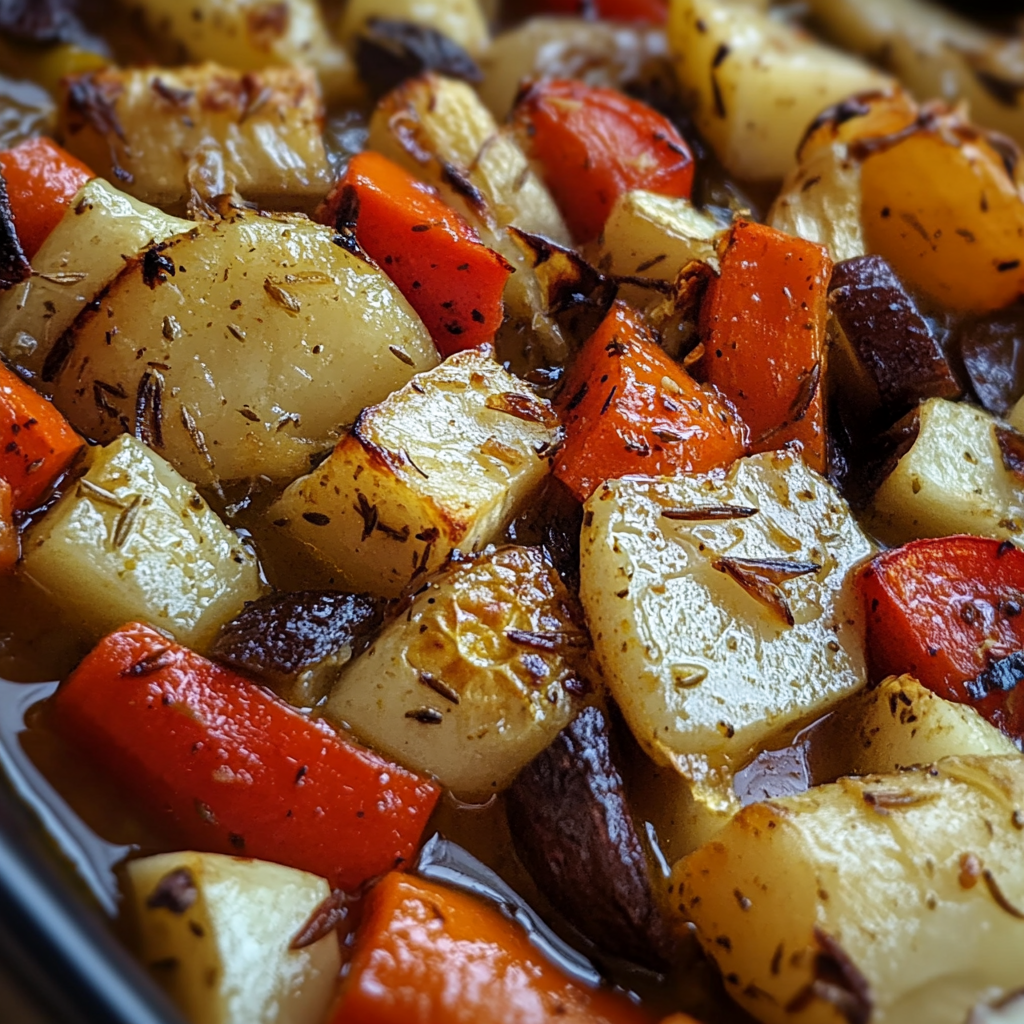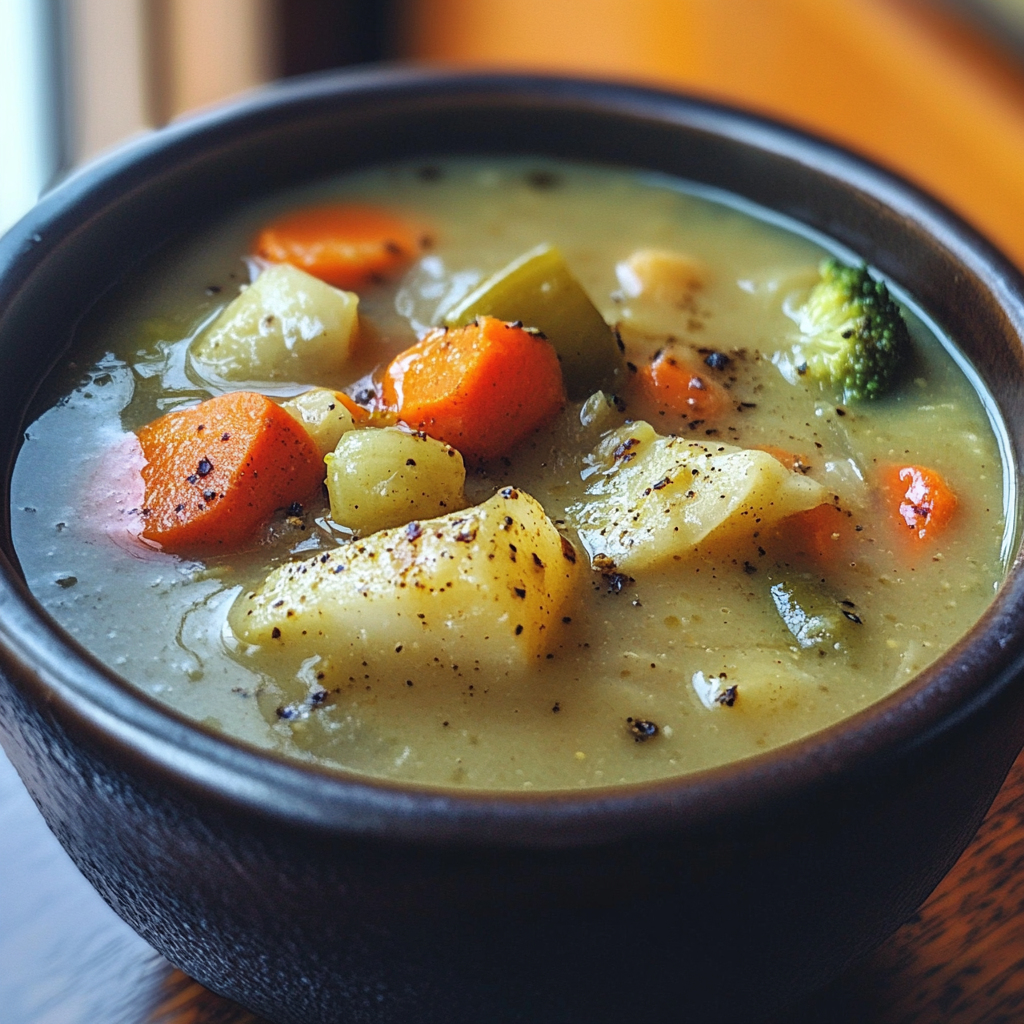Quick Overview
If you’re looking for a nutritious and flavorful dish to warm you up on chilly days, this roasted vegetable soup is the perfect choice. Packed with seasonal vegetables, it offers a delightful blend of flavors and textures. The roasting process caramelizes the vegetables, enhancing their natural sweetness and creating an irresistible goodness. In just a few steps, you can enjoy a bowl of comfort that’s not only delicious but also beneficial for your health.
Ingredient Breakdown
Fresh Vegetables
For the base of the soup, use a variety of fresh vegetables such as carrots, bell peppers, zucchini, and tomatoes. Aim for about 4 cups in total. These vegetables provide essential vitamins and minerals while adding depth to the flavor.
Garlic
You will need 4 cloves of garlic for this recipe. Minced garlic brings a robust aroma and enhances the overall taste of the soup. It adds a layer of flavor that complements the sweetness of roasted vegetables beautifully.
Olive Oil
Use 2 tablespoons of extra virgin olive oil. This oil not only helps in roasting but also adds healthy fats to your dish. It contributes to the richness of the soup while ensuring that the vegetables don’t stick to the pan.
Vegetable Broth
You will require 4 cups of low-sodium vegetable broth. This liquid is crucial as it forms the base of your soup. Choose low-sodium options to keep your dish healthier without compromising on flavor.
Herbs and Spices
Gather thyme, salt, and pepper as your go-to seasonings. Use 1 teaspoon of dried thyme along with salt and pepper to taste. These ingredients elevate the dish by adding aromatic notes that pair well with roasted veggies.
Step By Step Recipe: Roasted Vegetable Soup
Preheat Your Oven
Begin by preheating your oven to 400°F (200°C). This temperature ensures even roasting of the vegetables while allowing them to caramelize properly. Proper preheating is crucial for achieving that rich flavor profile we want in our soup.
Prepare Your Vegetables
While waiting for the oven to heat up, chop your fresh vegetables into bite-sized pieces. Aim for uniform sizes so they roast evenly. Place them in a large mixing bowl before proceeding to the next step.
Season Your Vegetables
Drizzle your chopped veggies with olive oil and add minced garlic along with salt, pepper, and thyme. Toss everything together until all pieces are evenly coated with oil and seasoning. This step ensures that each bite carries an explosion of flavor from your herbs and spices.
Roast Your Vegetables
Spread the seasoned vegetables onto a baking sheet in a single layer. Roast them in the preheated oven for about 25-30 minutes or until they are tender and golden brown around the edges. Stir halfway through cooking for even roasting results.
Blend Everything Together
Once your vegetables are done roasting, transfer them into a large pot over medium heat. Pour in your vegetable broth gradually while using an immersion blender or standing blender until smooth and creamy. This blending process creates that luscious texture we love in soups.
Adjust Seasoning & Serve
Taste your blended soup and adjust seasoning if necessary — add more salt or pepper according to preference. Reheat on low if needed before serving hot in bowls garnished with herbs or croutons for added crunch.
Serving and Storing Tips
Serving Suggestions
Serve your roasted vegetable soup warm with crusty bread or crackers on the side. You may also top it with fresh herbs like basil or parsley for an extra pop of color and flavor on each serving plate.
Storing Leftovers
Store any leftover soup in airtight containers in your refrigerator for up to five days. Reheat on low heat before serving again; stir well as it may thicken slightly when chilled.
Freezing Options
If you want to make larger batches, consider freezing portions in freezer-safe bags or containers! This allows you easy access to hearty meals later on; just thaw overnight before reheating when desired.
This roasted vegetable soup makes not only a great meal but also freezes well for future enjoyment! Try making it today; you’ll fall in love with its rich taste and health benefits!
Mistakes to avoid
When making roasted vegetable soup, one common mistake is not seasoning the vegetables adequately before roasting. Proper seasoning enhances the flavors and brings out the natural sweetness of the vegetables. Always use a generous amount of salt and pepper, along with your favorite herbs to ensure that each bite is flavorful.
Another mistake is overcrowding the roasting pan. When vegetables are too close together, they steam instead of roast. This prevents them from developing that desirable caramelization, which adds depth to your soup. Make sure to leave enough space between each vegetable piece for even cooking.
Failing to cut vegetables into uniform sizes can lead to uneven cooking. Different sizes will result in some pieces being undercooked while others become mushy. Aim for consistent cuts so that all vegetables cook evenly and contribute to a harmonious texture in your soup.
One more mistake is using low-quality broth or stock. The broth significantly impacts the final taste of your soup. Always opt for homemade or high-quality store-bought broth to enhance the overall flavor profile of your roasted vegetable soup.
Lastly, not blending the soup well enough can leave you with an undesirable texture. For a creamy consistency, blend until smooth. If you prefer a chunkier texture, blend just half of the soup and mix it back in with the unblended portion for a delightful contrast.
Tips and tricks
To create the best roasted vegetable soup, start with selecting fresh, seasonal vegetables. Seasonal produce not only tastes better but also offers more nutrients. Look for vibrant, firm vegetables at your local market or grocery store for optimal flavor.
Another tip is to roast your vegetables at a high temperature—around 425°F (220°C). High heat promotes caramelization, which intensifies flavors and sweetness in your vegetables. Toss them in olive oil and seasonings before placing them on a baking sheet for roasting.
Don’t forget about adding aromatics such as garlic and onions to your roasting process. These ingredients release their flavors during roasting and add depth to your soup base. Roast them alongside other vegetables for a rich flavor profile that will enhance every spoonful.
Consider adding fresh herbs at different stages of cooking; this adds layers of flavor throughout the process. For instance, add woody herbs like thyme or rosemary during roasting, while fresh herbs like parsley or basil can be added just before serving for brightness.
Finally, always taste as you go when making your soup! Adjusting seasoning throughout ensures a balanced final product. If it tastes flat at any point during preparation, don’t hesitate to add more salt, acid (like lemon juice), or spices until it sings with flavor.
Suggestions for Roasted Vegetable Soup
For extra creaminess in your roasted vegetable soup, consider adding coconut milk or heavy cream towards the end of cooking. This addition can transform the consistency from thin to luscious without overwhelming the original flavors.
You can also mix different types of vegetables beyond traditional carrots and potatoes. Try including butternut squash or sweet potatoes for natural sweetness. Adding greens like kale or spinach just before blending provides added nutrition without affecting flavor significantly.
If you want some heat in your roasted vegetable soup, consider incorporating red pepper flakes or diced jalapeños during roasting or blending stages. This subtle kick can elevate the dish while still allowing other flavors to shine through beautifully.
Garnish your finished soup with toasted seeds or nuts for added texture and crunch. Pumpkin seeds or sliced almonds work exceptionally well as toppings that provide both visual appeal and delicious contrast against the creamy base.
Lastly, serve your roasted vegetable soup with crusty bread on the side for dipping. A warm baguette or sourdough complements the rich flavors perfectly while providing a satisfying element that rounds out the meal nicely.
FAQs
What vegetables work best in roasted vegetable soup?
You can use a variety of vegetables in roasted vegetable soup, but some popular options include carrots, bell peppers, zucchini, tomatoes, and onions. Each brings distinct flavors and textures that enhance your final dish when roasted properly.
Can I make roasted vegetable soup ahead of time?
Absolutely! Roasted vegetable soup stores well in an airtight container in the refrigerator for up to five days. It’s also suitable for freezing—just allow it to cool completely before transferring it into freezer-safe containers for longer storage without compromising taste.
How do I thicken my roasted vegetable soup?
If you find your soup too thin after blending, there are several ways to thicken it up! You may let it simmer uncovered on low heat until some liquid evaporates or stir in cornstarch mixed with cold water until desired consistency is reached.
Is there a vegan version of this recipe?
Yes! Roasted vegetable soup can easily be made vegan by using vegetable broth instead of chicken broth and omitting any dairy products like cream or cheese from recipes aimed at enhancing creaminess while maintaining great flavor profiles!
What are some good side dishes to serve with roasted vegetable soup?
Roasted vegetable soup pairs wonderfully with various sides such as grilled cheese sandwiches, fresh salads topped with vinaigrette dressing, baked potatoes seasoned simply—buttered rolls make delightful accompaniments too!
Can I add protein to my roasted vegetable soup?
Yes! You can incorporate proteins such as chickpeas or lentils into your roasted vegetable soup either during cooking or as toppings once served hot! This approach adds nutritional value while keeping everything deliciously balanced yet filling!
Summary
In summary, creating delicious roasted vegetable soup involves avoiding common mistakes like inadequate seasoning and overcrowding pans while applying helpful tips like roasting at high temperatures and tasting throughout preparation. By considering suggestions such as using diverse vegetables and enhancing creaminess with coconut milk or nuts while addressing frequently asked questions about preparation methods ensures every bowl delivers satisfaction consistently! Enjoy crafting this comforting dish filled with warmth today!
Roasted Vegetable Soup
Description
If you’re looking for a nutritious and flavorful dish to warm you up on chilly days, this roasted vegetable soup is the perfect choice. Packed with seasonal vegetables, it offers a delightful blend of flavors and textures. The roasting process caramelizes the vegetables, enhancing their natural sweetness and creating an irresistible goodness. In just a few steps, you can enjoy a bowl of comfort that’s not only delicious but also beneficial for your health.
Ingredients
Fresh Vegetables
For the base of the soup, use a variety of fresh vegetables such as carrots, bell peppers, zucchini, and tomatoes. Aim for about 4 cups in total. These vegetables provide essential vitamins and minerals while adding depth to the flavor.
Garlic
You will need 4 cloves of garlic for this recipe. Minced garlic brings a robust aroma and enhances the overall taste of the soup. It adds a layer of flavor that complements the sweetness of roasted vegetables beautifully.
Olive Oil
Use 2 tablespoons of extra virgin olive oil. This oil not only helps in roasting but also adds healthy fats to your dish. It contributes to the richness of the soup while ensuring that the vegetables don’t stick to the pan.
Vegetable Broth
You will require 4 cups of low-sodium vegetable broth. This liquid is crucial as it forms the base of your soup. Choose low-sodium options to keep your dish healthier without compromising on flavor.
Herbs and Spices
Gather thyme, salt, and pepper as your go-to seasonings. Use 1 teaspoon of dried thyme along with salt and pepper to taste. These ingredients elevate the dish by adding aromatic notes that pair well with roasted veggies.





